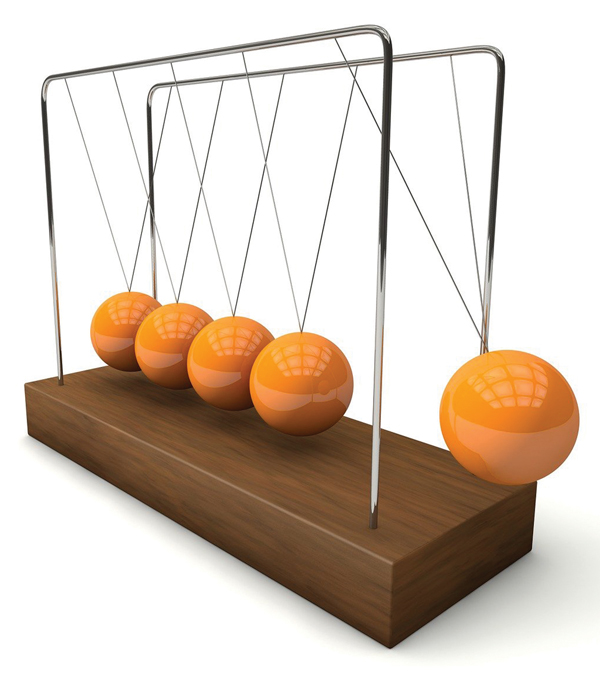Citizen Science by Jamie Zvirzdin
Kinetic Energy, the ‘Force Vive’

In the heart of Central New York, amid the crisp air and tranquil waters of the Finger Lakes, there’s an unstoppable force of nature that captures the very essence of kinetic energy better than any physics textbook: a 3-year-old loose in the grocery store.
How is it that you, with your longer legs and greater mass and intellect, can be so easily avoided and outstripped, from the candy aisle to the frozen food section and back to the cereal aisle? At time t = 0, when you told the child no, you would not buy Chocolate Nightmare Bombs, your child went from an initial velocity of v = 0 to at least 50 miles per hour (Actually, at full tilt, I estimate a 3-year-old can reach a velocity of 2 to 3 meters per second (m/s), or about 5 miles per hour, which indeed feels like 50 miles an hour when you’re tired and overwrought. For comparison, trained athletes in peak physical condition can do 10 m/s). Cans roll, packages tumble, grouchy looks of shoppers multiply, yet you still can’t catch up. What is this mysterious living force at play in your own child?
This speedy body of enviable energy offers a fitting illustration of kinetic energy, a concept dating back to the 18th century and the insightful work of Émilie Du Châtelet and Gottfried Wilhelm Leibniz. Understanding this force vive, as they called it, may help you gain enough kinetic energy to catch up with your child before the manager does.
As a pioneering philosopher-mathematician in France, Émilie Du Châtelet argued, as Leibniz did, that a fundamental quantity of motion existed beyond the idea of momentum, which she called the force morte, “the dead force” (momentum is mass multiplied by velocity, or mv). Beyond momentum must be the force vive, the living force, which in time was renamed kinetic energy—the energy an object or body possesses because of its motion. In her book “Foundations of Physics” (1740), she said that the energy of a moving object wasn’t just linked to its velocity, as Isaac Newton was claiming, but to the square of its velocity, or v². Velocity multiplied by itself meant that a very fast-moving body would have extremely high kinetic energy: a fast-pitched baseball, a speeding car, a skier in the Adirondack Mountains.
Applying Du Châtelet’s words to our grocery store escapee, you gasp in horror (and because you are out of breath) as your 3-year-old bolts down the cereal aisle, intent on knocking down all meter-high cereal boxes. You realize that if your child has a velocity of 3 m/s, then their squared velocity will be 9 m/s. You’ve made the critical error of trying to take the shopping cart with you, which transferred some of your kinetic energy into the cart (Work, remember, equals Force times Distance—the transfer of energy we talked about in the last column).
If you don’t abandon your cart, increase your velocity and fulfill the full kinetic energy formula, KE = ½ mv², you will never catch your child in time. (The ½ factor, by the way, comes from averaging the initial velocity (0 meters per second) and the final velocity (3 meters per second) to get the average velocity over the whole sprint). You must stop doing work on the shopping cart and increase your velocity to win this game.
As you abandon your cart at the top of the aisle, you do a final calculation: Your 3-year-old weighs roughly 15 kilograms (about 33 pounds) and therefore has a momentum of mv = 15 kg × 3 m/s = 45 kg·m/s of momentum. At top speed racing toward the cereal boxes, your child will have a kinetic energy of KE = ½ mv² = ½ × 15 kg × (9 m/s) = 67.5 kg·(m/s)² or 67.5 Joules (“Joules” is the fancy but rather confusing name that we use to denote the units of energy, named after an English brewer and physicist named James Prescott Joule. To be fair, “67.5 Joules” is easier to say than “67.5 kilograms times meters squared divided by seconds squared.”). Increasing your own force vive, you scoop up your child right as the first cereal box tumbles to the floor, its motion evidence that objects also have a kind of stored-up kinetic energy, called potential energy, which we’ll talk about next month.
The magnificent living force you have created may be a holy terror sometimes, but as you restore the cereal box from floor to shelf (doing work to transfer some of your energy back to the box) and see the sympathetic smiles of other parents, you pause to appreciate such great force vive in action, how palpable and dynamic and real kinetic energy is. Actual, calculable energy is far more beautiful, vivid and useful than any wishy-washy alternative medicine/new-age concept claiming to own the secrets of “life force energy” or “vital energy.” These counterfeits lack predictability, measurable precision and the empirical foundation of science to explain the world around us. Usually such pseudo-energy practitioners are willing to share their secrets with us for a pretty penny—pennies better spent at the grocery store on healthy food so we can keep up with our kiddos.
The concept of kinetic energy, with its scientific roots and real-world applications, extends far beyond the grocery store. It’s present in the falling leaves of New York autumns, the lapping waves of the Finger Lakes, the cold wind whistling across fields and up hillsides. Each of these instances embodies the force vive Du Châtelet described centuries ago, allowing us to connect with the very dynamics that animate our world, the cosmos and our own bodies.
Jamie Zvirzdin researches cosmic rays with the Telescope Array Project, teaches science writing at Johns Hopkins University and is the author of “Subatomic Writing.”

